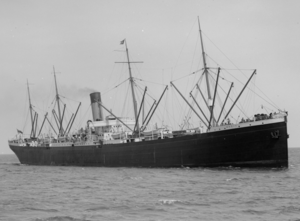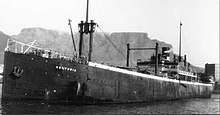SS Medic
 SS Medic | |
| History | |
|---|---|
| Name: | Medic |
| Owner: | White Star Line |
| Port of registry: | Liverpool |
| Builder: | Harland & Wolff, Belfast |
| Yard number: | 323 |
| Launched: | 15 December 1898 |
| Completed: | 6 July 1899 |
| In service: | August 1899 |
| Out of service: | 1927 |
| Identification: |
|
| Fate: | Sold, 1928 |
| Name: | Hektoria |
| Owner: | A/S Hektor (N. Bugge) |
| Port of registry: | Tønsberg |
| Acquired: | 1928 |
| Fate: | Ownership changed 1932 |
| Name: | Hektoria |
| Operator: | Hektor Whaling Ltd |
| Port of registry: | London |
| Acquired: | 1932 |
| Out of service: | 12 September 1942 |
| Fate: | Sunk, 12 September 1942 |
| General characteristics (as built)[2] | |
| Class and type: | Jubilee-class passenger-cargo ship |
| Tonnage: | 11,985 GT |
| Length: | 550 ft 2 in (167.69 m) |
| Beam: | 63 ft 3 in (19.28 m) |
| Propulsion: | 2 × 4-cylinder quadruple expansion steam engines, 2 shafts |
| Speed: | 13.5 knots (25.0 km/h; 15.5 mph) |
| Capacity: |
|
SS Medic was a steamship built by Harland and Wolff in Belfast for the White Star Line which entered service in 1899. Medic was one of five Jubilee Class ocean liners (the others being the Afric, Persic, Runic and Suevic) built specifically to service the Liverpool–Cape Town–Sydney route.[2]
Medic was the second Jubilee Class ship to be built for the Australia service. Like her sisters she was a single funnel liner, measuring just under 12,000 gross tons, which had capacity for 320 Third Class passengers, and also had substantial cargo capacity with seven cargo holds, most of them refrigerated for the transport of Australian meat.[3][2]
The ship's name pertained to the ancient Persian region of Media and was pronounced Meedick.[3]
After a long career with White Star, Medic was sold in 1928 and was converted into a whaling factory ship and renamed Hektoria, she remained in service in this role until being torpedoed and sunk in 1942.
White Star Line career
Medic was launched at Belfast on 15 December 1898, but her completion was delayed until 6 July the following year, so that improvements that were being made to her earlier sister Afric could be incorporated into her construction.[3]
Medic inaugurated White Star's new Australia service with her maiden voyage, which started from Liverpool on 3 August 1899, she was then the largest ship ever to sail to Australia.[4][5] Although Afric was the first ship built for the service, she did not make her first voyage to Australia until the following month. On board the maiden voyage was Charles Lightoller on his first assignment as Fourth Mate, he would later become the only senior officer to survive the sinking of the RMS Titanic.[3] He would write of Medic's reception upon her arrival in Sydney:
- "She was a show ship, the biggest that had ever been out there, and the people in Australia gave us the time of our lives. Everything and everywhere it was Medic"[3]
On her first return trip to the UK, Medic carried Australian troops to South Africa for the Boer War which had started in October 1899, and continued to carry troops to the conflict until it concluded in 1902. In October 1900, while Medic was anchored in Neutral Bay, Sydney Harbour, Charles Lightoller and some shipmates were involved in the "Fort Denison Incident", a prank intended to fool locals into believing a Boer raiding party was attacking the city. The culprits were never apprehended but Lightoller confessed to his company's superiors, after which he was transferred to the Atlantic route.[6]

On 15 June 1907 Medic collided with the 4,134 ton petroleum tank steamer Turbo in fog in the English Channel off the Kent coast while sailing from London to Liverpool. The Turbo was seriously damaged and had to be towed to harbour:[7] The damage to Medic at first appeared to only consist of a crack above the waterline, and so she continued her voyage to Liverpool where she was dry docked for a more thorough examination of the damage: Here it was discovered that Medic had a 5 sq ft (0.46 m2) hole below the waterline; several lumber plates having been loosened and displaced.[8]
Medic initially continued on her scheduled commercial service following the outbreak of the First World War in 1914, because of her large refrigerated meat carrying capacity, however she also carried Australian troops to Britain, as such she gained the designation HMAT (His Majesty's Australian Transport) A7. In November 1914 John Simpson Kirkpatrick departed Australia onboard Medic, he would later become famous for his role as a stretcher bearer during the Gallipoli Campaign. In May 1915 Medic was refitted at Sydney to transport 531 troops and 500 horses, to make her better suited to her wartime role.[9] Medic was later commandeered under the British Liner Requisition Scheme in October 1917, and was used as a troopship, until being released from government service in March 1919, after which she returned to the Australian service.[3]
In 1920 Medic underwent a refit where her passenger accommodation was modernised and reconfigured to carry 260 passengers in Second class.[4] She continued in service on the Australian route for most of the 1920s, in consort with the Persic, Runic and Suevic. She made her last voyage for White Star on this route in December 1927, following her return she was laid up for disposal after 28 years of service.[3]
Hektoria
In June 1928 Medic was sold for £35,000 to A/S Hektor (N. Bugge) of Tønsberg, Norway, who converted her into a whale factory ship and renamed her Hektoria. The conversion was carried out by Grayson Rollo and Clover Docks at Birkenhead, and involved the installation of a stern ramp, whereby whale carcasses could be hauled onto deck, the fitting of eighteen large cargo tanks which could hold 8,000 tons of whale oil, and the enlargement of her coal bunkers. Altogether the refit increased the gross tonnage of the ship to 13,834. Hektoria was ready for service for the 1928/29 whaling season off South Georgia.[3][9]
On 22 September 1928 the members of the Wilkins-Hearst Antarctic Expedition boarded Hektoria at New York, they would live on board the ship for the next five months.[10] The Hektoria Glacier in the Antarctic was named after the ship by the expedition.[11]

In 1932 Hektoria returned to the British register after her ownership was transferred to Hektor Whaling Ltd of London, but remained involved in the same trade as before.[3]
On the outbreak of World War II, Hektoria was requisitioned by the Ministry of War Transport for use as an oil tanker. She finally met her end on 12 September 1942 after being torpedoed and sunk by the German U-boat U-608, at the position (48°55′N 33°38′W / 48.917°N 33.633°W) while sailing in the Atlantic convoy ON 127.[2][3] One crewman lost his life, but the master, 76 crew members and eight gunners survived and were picked up by the Canadian corvette, HMCS Arvida.[12]
References
| Wikimedia Commons has media related to Medic (ship, 1899). |
| Wikimedia Commons has media related to Hektoria (ship, 1899). |
- ↑ "Medic, White Star Line". norwayheritage.com. 2013. Retrieved 25 February 2013.
- 1 2 3 4 Clarkson, Andrew (2013). "SS Medic". titanic-titanic.com. Retrieved 25 February 2013.
- 1 2 3 4 5 6 7 8 9 10 Kerbrech, Richard De (2009). Ships of the White Star Line. Ian Allen Publishing. pp. 78–80. ISBN 978 0 7110 3366 5.
- 1 2 Haws, Duncan (1990). White Star Line (Oceanic Steam Navigation Company). p. 52. ISBN 0 946378 16 9.
- ↑ "A MAMMOTH STEAMSHIP. THE NEW WHITE STAR LINER. ARRIVAL OF THE MEDIC". The North Queensland Register. IX, (43). Queensland, Australia. 2 October 1899. p. 25. Retrieved 10 September 2018 – via National Library of Australia.
- ↑ Lightoller, Charles H. (1935). "Chapters 27-28". Titanic and Other Ships (eBook). Australia: Project Gutenberg.
- ↑ "COLLISION IN THE ENGLISH CHANNEL. A TANK STEAMER DAMAGED". The West Australian. 17 June 1907. Retrieved 12 August 2018.
- ↑ "MEDIC IN COLLISION". Observer (Adelaide}. 22 June 1907. Retrieved 12 August 2018.
- 1 2 "A7 MEDIC 1899-1942". Flotilla Australia. Retrieved 17 August 2018.
- ↑ "Hubert Wilkins 1888-1958". south-pole.com. Retrieved 24 July 2018.
- ↑ Alberts, Fred G., ed. (June 1995). Geographic Names of the Antarctic (PDF) (second ed.). United States Board on Geographic Names. p. 324. Retrieved 2012-04-05.
- ↑ Helgason, Guðmundur. "Hektoria (Whale factory ship) – Ships hit by U-boats". German U-boats of WWII - uboat.net. Retrieved 27 February 2014.